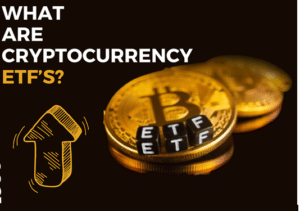Currency and Cryptocurrency ETFs are some of the most sought-after investment products given their ability to broaden investment exposure and stifle the impact of extreme market volatility. They stand out partly because they allow investors to short the market gain leverage and wide exposure.
Understanding cryptocurrency ETFs
Cryptocurrency ETFs are similar to traditional ETFs but with the caveat of only tracking a basket of one or more virtual currencies or digital tokens. At the same time, tracking the value of underlying assets allows investors to gain exposure to a wide pool of digital assets instead of investing in individual assets.

Source: Quora.com
Unlike typical digital assets that trade in crypto exchanges, the ETFs trade in a normal exchange such as NYSE or NASDAQ. Their listing in mainstream exchanges affirms their credibility and security compared to digital asset exchanges that are unregulated and prone to attacks.
However, the listing of such products in mainstream exchanges also exposes investors to hefty management fees, among other limitations.
How they work
Cryptocurrency ETFs work by a fund provider setting up and owning underlying assets. The assets can be Bitcoin, Ethereum, Ripple, Litecoin, etc., all pulled to form one big basket. The setup will track the price of all the listed digital tokens in the ETF.
The fund provider must own the underlying digital tokens. Investors, in return, don’t purchase the individual assets but a portion of the entire fund. By owning the digital assets indirectly, investors gain exposure to a wide pool without having to contend with the accompanying expenses and risks of owning outright.

Source: Cryptopotato.com
The most common products on this front are Bitcoin ETFs that don’t own the coin directly but stock portfolios of companies exposed to blockchain technology. While Bitcoin ETFs exist in the U.S., they don’t own the actual cryptos but stock portfolios with exposure to the underlying ledger technology.
Bitcoin ETFs have gained prominence in Canada. The country is also home to Ethereum ETFs. Other countries led by Australia, Japan, UAE are also considering listing such funds.
The pros
Cryptocurrency ETFs stand out partly because they can be bought and sold using mainstream brokerage accounts. In addition, people don’t require digital wallets as there is no ownership of the individual assets. The fact that they are issued by regulated companies and listed on mainstream exchanges adds a layer of credibility by reducing the risk of fraud.
Some government agencies also regulate such investment assets, thus eligible for investment via tax plans. Additionally, they own a basket of digital assets, thus offering broad exposure as opposed to owning one coin that may be affected by extreme volatility.
The cons
However, they come with the limitation of people not owning the actual coin; thus, one cannot exchange one coin for another. People also don’t enjoy the decentralized financial system offered by the underlying sets.
The biggest downside has to deal with the fact that such investment vehicles come with high management fees compared to traditional ETFs.
Understanding currency ETFs

Source: Investopedia.com
Currency ETFs are investment vehicles that offer exposure to a basket of one or several currency pairs in the forex market. Instead of buying a fiat pair, one gets to invest in a basket that has already bought an array of currency pairs. The fund, in this case, tracks the value of a currency or basket of currencies.
How do they work?
They operate the same way as stocks as they are traded in normal stock market exchanges such as NYSE. Therefore, investors purchase shares of individual currencies but gain exposure to a pool of currencies rather than one pair. They stand out partly because they offer a seamless and cheap way of trading various currencies at a go.
Pros
Currency ETFs offer an ideal way of diversifying an investment portfolio in the forex market. In addition, they can be used as a hedge against the relative value of a given fiat pair. The fact that they trade on the market means they can be bought using existing brokerage accounts.
Lower transaction fees are arguably the biggest upside of trading this form of investment product. In addition, people can buy and sell them without incurring transaction fees involved in transacting currencies. The fact that they are not actively managed also sees them come with low management fees.
Cons
Basket risk has to be the biggest downside of such investment products as investors must have a clear understanding of each currency to ensure risk is properly distributed. Adding many currency pairs into the basket only adds a level of complexity and increases the risk of an investor being wrong.
Volatility is another important aspect that investors should pay close attention to, given that currency pairs are subject to the downside risk of various economic policies of various countries and regulations.
Currency ETFs vs. cryptocurrency pairs
The two share an array of attributes as they offer exposure to a basket of assets. However, they come with their fair share of differences.
Currency ETFs have been in existence and operation for a long time, thus much bigger in market capitalization than their counterparts and tend to attract big institutional investments. In addition, they boast of a better regulatory framework, given that virtual assets are still a grey area in most jurisdictions.
Additionally, there is a wide pool of currency ETFs to choose from compared to crypto ETFs that are only getting started. High transactional and management fees are another downside to trading such funds compared to currency ETFs.
Final thoughts
Exchange-traded funds offer an ideal way of gaining exposure to a given market. Therefore, for any investor looking to gain broad exposure in the forex market, currency ETFs will always fit the bill. However, for investors looking to gain exposure in the burgeoning blockchain sector, cryptocurrency ETFs will always be a solid bet. Performance would always come down to the kind of assets included in any of the funds.